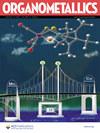硅烷-Cp 配体支持的稀土烷基:合成、反应活性以及炔烃和胺与碳二亚胺的催化加成
IF 2.5
3区 化学
Q2 CHEMISTRY, INORGANIC & NUCLEAR
引用次数: 0
摘要
稀土金属二烷基在各种化学转化(如不饱和基质的氢元素化和烯烃聚合)中备受关注。然而,由于热稳定性差,稳定的稀土二烷基数量仍然非常有限。本文采用硅胺功能化环戊二烯配体 C5Me4H-Si(L)═NR(L = PhC(NtBu)2,R = 2,6-iPr2C6H3 表示 1,SiMe3 表示 2)来合成钇和钪二烷基化合物 (3-5)。硅亚氨基-Cp 二烷基钇 3 与苯胺和 2,6-二甲基吡啶的σ键元合成反应分别生成了二烷基钇络合物(6)和 C(sp3)-H 键活化的二苄基钇络合物(7)。3 与 N,N′-二异丙基碳二亚胺反应生成二亚胺酸钇络合物(8)。钇和钪二烷基 3 和 5 以及反应产物 6-thf、7 和 8 已通过 X 射线衍射分析确定了结构特征。值得注意的是,在末端炔和胺与碳二亚胺的催化加成中,硅亚氨基羰基钇二烷基 4 表现出高活性和优异的官能团耐受性。本文章由计算机程序翻译,如有差异,请以英文原文为准。
Rare-Earth Dialkyls Supported by Silaimine-Cp Ligand: Synthesis, Reactivity, and Catalytic Addition of Alkynes and Amines to Carbodiimides
Rare-earth metal dialkyls have attracted considerable attention in a variety of chemical transformations, such as hydroelementation of unsaturated substrates and olefin polymerization. However, stable rare-earth dialkyls are still very limited in number because of their poor thermal stability. In this paper, silaimine-functionalized cyclopentadienyl ligands C5Me4H–Si(L)═NR (L = PhC(NtBu)2 and R = 2,6-iPr2C6H3 for 1 and SiMe3 for 2) were applied for the synthesis of yttrium and scandium dialkyls (3–5). σ-Bond metathesis reactions of silaimine-Cp yttrium dialkyl 3 with aniline and 2,6-dimethylpyridine yielded the yttrium diamide complex (6) and the C(sp3)–H bond-activated yttrium dibenzyl complex (7), respectively. The yttrium diamidinate complex (8) was generated from the reaction of 3 with N,N′-diisopropylcarbodiimide. The yttrium and scandium dialkyls 3 and 5 and the reaction products 6-thf, 7, and 8 have been structurally characterized by X-ray diffraction analysis. Notably, silaimine-Cp yttrium dialkyl 4 displayed high activity and excellent functional group tolerance in the catalytic addition of terminal alkynes and amines to carbodiimides.
求助全文
通过发布文献求助,成功后即可免费获取论文全文。
去求助
来源期刊

Organometallics
化学-无机化学与核化学
CiteScore
5.60
自引率
7.10%
发文量
382
审稿时长
1.7 months
期刊介绍:
Organometallics is the flagship journal of organometallic chemistry and records progress in one of the most active fields of science, bridging organic and inorganic chemistry. The journal publishes Articles, Communications, Reviews, and Tutorials (instructional overviews) that depict research on the synthesis, structure, bonding, chemical reactivity, and reaction mechanisms for a variety of applications, including catalyst design and catalytic processes; main-group, transition-metal, and lanthanide and actinide metal chemistry; synthetic aspects of polymer science and materials science; and bioorganometallic chemistry.
 求助内容:
求助内容: 应助结果提醒方式:
应助结果提醒方式:


